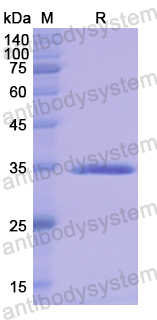Catalog No.
YHK01901
Expression system
E. coli
Species
Homo sapiens (Human)
Protein length
Thr234-Asn420
Predicted molecular weight
21.73 kDa
Nature
Recombinant
Endotoxin level
Please contact with the lab for this information.
Purity
>90% as determined by SDS-PAGE.
Accession
Q9H6P5
Applications
ELISA, Immunogen, SDS-PAGE, WB, Bioactivity testing in progress
Form
Lyophilized
Storage buffer
Lyophilized from a solution in PBS pH 7.4, 0.02% NLS, 1mM EDTA, 4% Trehalose, 1% Mannitol.
Reconstitution
Reconstitute in sterile water for a stock solution. A copy of datasheet will be provided with the products, please refer to it for details.
Shipping
In general, proteins are provided as lyophilized powder/frozen liquid. They are shipped out with dry ice/blue ice unless customers require otherwise.
Stability and Storage
Use a manual defrost freezer and avoid repeated freeze thaw cycles. Store at 2 to 8°C for frequent use. Store at -20 to -80°C for twelve months from the date of receipt.
Alternative Names
C20orf13, Threonine aspartase 1, Taspase-1, TASP1
Identification and map-based cloning of an EMS-induced mutation in wheat gene TaSP1 related to spike architecture., PMID:38709271
Developmental reprogramming of myometrial stem cells by endocrine disruptor linking to risk of uterine fibroids., PMID:37650943
Circ_0059457 Promotes Proliferation, Metastasis, Sphere Formation and Glycolysis in Breast Cancer Cells by Sponging miR-140-3p to Regulate UBE2C., PMID:37284894
Disorders of histone methylation: Molecular basis and clinical syndromes., PMID:35713103
The Taspase1/Myosin1f-axis regulates filopodia dynamics., PMID:35601920
Suleiman-El-Hattab syndrome: a histone modification disorder caused by TASP1 deficiency., PMID:35512351
Taspase1 orchestrates fetal liver hematopoietic stem cell and vertebrae fates by cleaving TFIIA., PMID:34156981
TASP1 Promotes Proliferation and Migration in Gastric Cancer via EMT and AKT/P-AKT Pathway., PMID:34012990
Neoantigen-reactive T cells exhibit effective anti-tumor activity against colorectal cancer., PMID:33689574
Novel genetic risk factors influence progression of islet autoimmunity to type 1 diabetes., PMID:33154504
TASP1 Promotes Gallbladder Cancer Cell Proliferation and Metastasis by Up-regulating FAM49B via PI3K/AKT Pathway., PMID:32071545
Site-specific proteolytic cleavage prevents ubiquitination and degradation of human REV3L, the catalytic subunit of DNA polymerase ζ., PMID:32064513
Homozygous loss-of-function variants of TASP1, a gene encoding an activator of the histone methyltransferases KMT2A and KMT2D, cause a syndrome of developmental delay, happy demeanor, distinctive facial features, and congenital anomalies., PMID:31209944
Regulation of MLL/COMPASS stability through its proteolytic cleavage by taspase1 as a possible approach for clinical therapy of leukemia., PMID:30573454
A Strategy To Isolate Modifiers of Caenorhabditis elegans Lethal Mutations: Investigating the Endoderm Specifying Ability of the Intestinal Differentiation GATA Factor ELT-2., PMID:29593072
Taspase 1: A protease with many biological surprises., PMID:27308523
Integrative Analysis of the Developing Postnatal Mouse Heart Transcriptome., PMID:26200114
Taspase1-dependent TFIIA cleavage coordinates head morphogenesis by limiting Cdkn2a locus transcription., PMID:25664857
Taspase1 cleaves MLL1 to activate cyclin E for HER2/neu breast tumorigenesis., PMID:25267403
Gene expression profile analysis of primary glioblastomas and non-neoplastic brain tissue: identification of potential target genes by oligonucleotide microarray and real-time quantitative PCR., PMID:18398573
EPS15R, TASP1, and PRPF3 are novel disease candidate genes targeted by HNF4alpha splice variants in hepatocellular carcinomas., PMID:18395097




